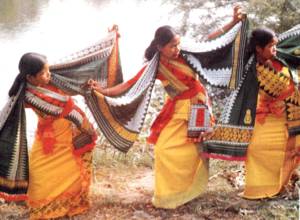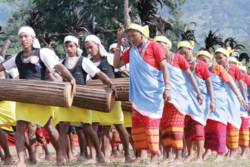Archives
Folk and Electronic Media Mergre for Development
i. Folk media
ii. Print media
iii. Electronic media, and
iv. New media.
Folk media is a term which is used to signify people’s performances. It talks about folk dance, rural drama and the musical variety of rural people. Creative use of folk media, in cultures where it is popular and well entrenched, can be a subtle and effective way of introducing development ideas and messages. Care is however required to ensure that the mix of entertainment and development is appropriate, so furthering the latter without damaging the former.
Print media includes newspapers, magazines, books, etc. These are well designed, carefully written for their intended audience; printed materials can provide a vitally important and cheap source of reference for extensions, and for literates among the rural population.
Electronic media includes TV, radio and film. Although potentially powerful, television is not easy for agricultural and rural development in most developing countries and radio is an excellent medium for motivation and for drawing attention to new ideas and techniques but weak for providing knowledge and training.
New media is a new concept in mass communication. It includes the internet. It helps us to get quick information in various fields. With the help of the internet, we can also get knowledge about our own culture.
In this article, I am going to focus on how folk media scores over electronic media in the north East region of India.
ADVANTAGE OF FOLK MEDIA
Folk media can touch the heart and mind of people because it is their own art. It is performed by local people, so people have a personal and emotional attachment to it. This is the cheapest among the different types of media. Folk media also has another advantage I that it is very flexible. For example, the lyrics of a song can easily be changed to give out information to the rural people.
ADVANTAGE OF FOLK MEDIA OVER ELECTRONIC MEDIA

Villagers show the true face of the northeastern part of India. In this region, rural people constitute about 80 percent of the total population with the remaining 20 percent living in urban areas. Although a large number of rural areas are slowly being converted into towns and urban areas, the rural area is much larger than the urban areas. The rural areas are home to about 80 percent of the total population of the North east and so, the economy, culture, etc of this region largely depends on the rural areas. It is a widely accepted fact that in order to develop the North East, we should first develop the rural parts of this region. Nowadays, the Central government and the State governments make various plans and policies for the rural people. However, due to lack of proper communication, these plans and policies often fail to reach the target audience. The rural people are generally very poor and are largely engaged in agricultural work or activities related to agriculture. They are not very literate and the knowledge level of rural people is very low. They do not understand high level language and the fast cultural change of this era. However, the word ‘folk’ which implies customs, habits and the way of life has existed in society from time immemorial and has been handed down from one generation to the next. Therefore, folk media is a popular means of communication among them. It is also an effective mass media among the rural people. It is true that rural people also use electronic media for communication and entertainment but they do not understand all the programs and information broadcasted or telecasted through this media. Thus, folk media can be used in electronic media to communicate with the rural people.
In actuality, folk media has a clear – cut advantage over electronic media. The familiarity, personal contact, common language, intelligibility, credibility and acceptance make folk media universally acceptable among rural people. In electronic media such as TV and radio, messages come out of an impersonal electronic box, but in folk media, there is a very close contact between the sender and the receiver. As the contact is direct and personal, the messages in folk media are far more credible and acceptable than if they were transmitted through the electronic media. The rural people are also very religiously inclined. They love their religion and are devoted to it, so, if we talk to them in terms of myths and legends which are a part of their religion, they can understand the messages properly. Folk media has been reckoned as successful motivators. They inspire the masses in times of stress and strain. The appeal of folk media is personal and is at an intimate level because it has got direct influence on people. Folk media is more flexible and repeatable than electronic media. If we want to repeat a particular message through electronic media, it turns out to be very expensive, but repeating one particular message through folk media is far easier and far cheaper than doing so through electronic media. Electronic media has an advantage in that it can reach large number at the same time whereas in folk media, it takes a long time to reach a larger audience. The reach, in terms of numbers, is greater in electronic media but effective reach is far greater through folk media. So we can say that if we convey a message through electronic media, we can cover a large audience even though it is not really effective to the audience. Similarly, if we use folk media, the message must be effective for the people but we can not reach a large audience through this medium. However, if we use folk media in electronic media, then we can get the double advantage of reaching a large audience with greater effectiveness in a single effort.
We can use different forms of folk media such as folk dances, folk music, folk songs, folk theatre to convey messages to the people of rural areas. To convey messages to these people, we should use the folk media of the region. That is to say, to convey messages in North East India, we should use the folk media of North East India. Bihu, Deodhani, Rasalia, Oja – pali, Ballads, Jatra, Puppets, Borgeet, Zikir, Oineetam, Lu Khang thamo, Gha to kito, Rechungma, Khullong ishei, Pena ishei, Lai haraoba ishei, Thoubal Chongba, Gaur Padas, Stret play, Bamboo dance, Nongkrem, Wangala, Polemo, Dorogata, Lahu, Rallu Lam,Chailam, Jangtalam, Aainam, Aankiya Naat, Nagara Naam, etc are popular folk media of the North East region. Among these, some are very powerful and effective means of communication.
The North East is home to diverse songs, dance and drama. All the eight states of this region are culturally rich. To learn more about the folk culture of the North East, I met some people related to folk culture. They told me about the folk culture of the North East and how folk media can convey messages among the rural masses. Muktananda Baruah, who is related to Oja – pali said that Oja – pali can be used to convey messages about various issues related to society and if this is used in electronic media to disseminate information, it becomes much more effective upon its target audience.
We can say that folk media is the media of the people. It has a direct attachment with the common people so it attaches itself to people’s mind. The language of folk media is local and thus messages through it more easily understood. If folk media is presented to a larger audience through the help of the electronic media it can be all the more effective. The advantage of electronic media is that the programmes aired by it are attractive and thus, people are drawn to it. It may be mentioned here that nowadays, various advertising agencies and companies use folk songs, dance and drama to convey information among the rural people. The National Rural Health Mission uses the folk media in electronic media to convey messages effectively to the rural masses. Another famous programme of Guwahati Doordarshan Kendra named ‘Kalyani’ also use folk media to disseminate information among rural people. The same can be said about the AIDS Control Society.
In closing, I reiterate that in order to develop the North East region, we need to start at the grass roots level and gradually work our way up. I feel that it has been proved beyond any doubt that using folk media through electronic media is the best way to reach the people in the rural areas. It is a strategy that has been tried out by a few government and non government organisations as the ones mentioned in the previous paragraph but I think that it has not been exploited to its full potential. If we are bring about development, we should seriously consider this merger of the old and the new.

